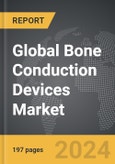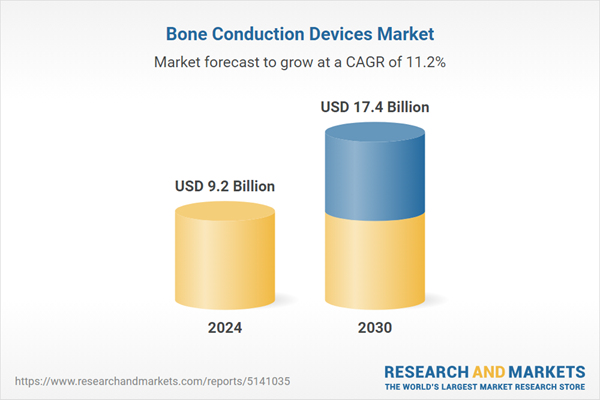The global market for Bone Conduction Devices was valued at US$9.2 Billion in 2024 and is projected to reach US$17.4 Billion by 2030, growing at a CAGR of 11.2% from 2024 to 2030. This comprehensive report provides an in-depth analysis of market trends, drivers, and forecasts, helping you make informed business decisions. The report includes the most recent global tariff developments and how they impact the Bone Conduction Devices market.
Segments: Device (Bone Conducting Headphones, Bone Anchored Hearing Aids); End-Use (Hospitals, ENT Clinics, Ambulatory Surgery Centers).
Geographic Regions/Countries: World; United States; Canada; Japan; China; Europe (France; Germany; Italy; United Kingdom; Spain; Russia; and Rest of Europe); Asia-Pacific (Australia; India; South Korea; and Rest of Asia-Pacific); Latin America (Argentina; Brazil; Mexico; and Rest of Latin America); Middle East (Iran; Israel; Saudi Arabia; United Arab Emirates; and Rest of Middle East); and Africa.
The analysts continuously track trade developments worldwide, drawing insights from leading global economists and over 200 industry and policy institutions, including think tanks, trade organizations, and national economic advisory bodies. This intelligence is integrated into forecasting models to provide timely, data-driven analysis of emerging risks and opportunities.
Global Bone Conduction Devices Market - Key Trends and Drivers Summarized
What Are Bone Conduction Devices and How Do They Revolutionize Hearing?
Bone conduction devices represent a groundbreaking advancement in auditory technology, offering an alternative to traditional hearing aids by bypassing the outer and middle ear to directly stimulate the cochlea. These devices operate on the principle of bone conduction, where sound vibrations are transmitted through the bones of the skull to the inner ear, allowing individuals with conductive hearing loss or specific types of sensorineural hearing loss to perceive sound. Unlike conventional hearing aids, which amplify sound through the air, bone conduction devices provide a direct pathway for sound transmission, which can be especially beneficial for individuals with conditions like chronic ear infections, atresia, or single-sided deafness. The technology has evolved to include both surgically implanted and non-surgical options, broadening its accessibility and usability. With their discreet design and capacity to improve sound clarity without the need for an ear canal device, bone conduction devices are revolutionizing the way we think about hearing restoration.How Are Bone Conduction Devices Evolving in Technology and Application?
The evolution of bone conduction devices has been marked by significant technological advancements that enhance their performance and usability. Early models were primarily external devices that attached to the skull, but recent innovations have led to more refined and comfortable designs. Surgically implanted bone conduction devices now feature advanced osseointegration techniques, where the implant integrates seamlessly with the bone, providing more stable and efficient sound transmission. Meanwhile, non-surgical devices have become increasingly sophisticated, with improvements in battery life, wireless connectivity, and sound quality. Many of these devices are now compatible with smartphones and other digital platforms, enabling users to customize their hearing experience through apps that allow for fine-tuning of sound settings. Additionally, miniaturization of components has made bone conduction devices more discreet, increasing their appeal to a broader audience, including those who may have been hesitant to use traditional hearing aids due to cosmetic concerns.What Challenges Do Bone Conduction Devices Face and What Innovations Address Them?
Despite their advantages, bone conduction devices face several challenges that limit their widespread adoption. One of the primary issues is the variability in outcomes, as the effectiveness of bone conduction can differ significantly between individuals depending on the condition of their bones and the specific nature of their hearing loss. To address this, manufacturers are investing in personalized fitting techniques and adjustable devices that can be tailored to the user's anatomy. Another challenge is the surgical aspect of implanted devices, which, while generally safe, carries inherent risks and can be a deterrent for some patients. In response, non-surgical options are being developed to offer comparable sound quality and comfort without the need for invasive procedures. Furthermore, the high cost of these devices, particularly the implanted versions, remains a barrier to access for many potential users. Efforts to reduce costs through more efficient manufacturing processes and the introduction of affordable models are ongoing. Additionally, innovations in materials and design are focused on reducing the size and visibility of the devices while enhancing durability and user comfort, making them more attractive and practical for everyday use.What Is Driving the Growth of the Bone Conduction Device Market?
The growth in the bone conduction device market is driven by several factors that reflect broader technological trends and shifts in consumer behavior. The increasing prevalence of hearing loss, particularly among the aging population, is a significant driver, as more people seek effective hearing solutions that offer comfort and discretion. Technological advancements, such as the integration of bone conduction technology with digital platforms, are also fueling market expansion by providing users with more control over their hearing experience. The trend toward personalization in healthcare is leading to the development of customized bone conduction devices that can be tailored to the unique needs of each patient, further boosting demand. Additionally, the rising popularity of wearable technology has made consumers more receptive to devices that blend seamlessly into their daily lives, such as bone conduction headsets for both medical and recreational use. Regulatory approvals and increasing awareness of bone conduction technology as a viable alternative to traditional hearing aids are also contributing to market growth, as more healthcare providers recommend these devices to patients. Finally, the ongoing development of less invasive, more affordable options is making bone conduction technology accessible to a wider audience, ensuring its continued growth in the coming years.Report Scope
The report analyzes the Bone Conduction Devices market, presented in terms of units. The analysis covers the key segments and geographic regions outlined below.Segments: Device (Bone Conducting Headphones, Bone Anchored Hearing Aids); End-Use (Hospitals, ENT Clinics, Ambulatory Surgery Centers).
Geographic Regions/Countries: World; United States; Canada; Japan; China; Europe (France; Germany; Italy; United Kingdom; Spain; Russia; and Rest of Europe); Asia-Pacific (Australia; India; South Korea; and Rest of Asia-Pacific); Latin America (Argentina; Brazil; Mexico; and Rest of Latin America); Middle East (Iran; Israel; Saudi Arabia; United Arab Emirates; and Rest of Middle East); and Africa.
Key Insights:
- Market Growth: Understand the significant growth trajectory of the Bone Conducting Headphones segment, which is expected to reach US$10.8 Billion by 2030 with a CAGR of a 10.8%. The Bone Anchored Hearing Aids segment is also set to grow at 11.8% CAGR over the analysis period.
- Regional Analysis: Gain insights into the U.S. market, valued at $2.4 Billion in 2024, and China, forecasted to grow at an impressive 14.6% CAGR to reach $4.1 Billion by 2030. Discover growth trends in other key regions, including Japan, Canada, Germany, and the Asia-Pacific.
Why You Should Buy This Report:
- Detailed Market Analysis: Access a thorough analysis of the Global Bone Conduction Devices Market, covering all major geographic regions and market segments.
- Competitive Insights: Get an overview of the competitive landscape, including the market presence of major players across different geographies.
- Future Trends and Drivers: Understand the key trends and drivers shaping the future of the Global Bone Conduction Devices Market.
- Actionable Insights: Benefit from actionable insights that can help you identify new revenue opportunities and make strategic business decisions.
Key Questions Answered:
- How is the Global Bone Conduction Devices Market expected to evolve by 2030?
- What are the main drivers and restraints affecting the market?
- Which market segments will grow the most over the forecast period?
- How will market shares for different regions and segments change by 2030?
- Who are the leading players in the market, and what are their prospects?
Report Features:
- Comprehensive Market Data: Independent analysis of annual sales and market forecasts in US$ Million from 2024 to 2030.
- In-Depth Regional Analysis: Detailed insights into key markets, including the U.S., China, Japan, Canada, Europe, Asia-Pacific, Latin America, Middle East, and Africa.
- Company Profiles: Coverage of players such as Abco Tech, Aftershokz, Audio Bone, Cochlear, Damson Audio and more.
- Complimentary Updates: Receive free report updates for one year to keep you informed of the latest market developments.
Some of the 47 companies featured in this Bone Conduction Devices market report include:
- Abco Tech
- Aftershokz
- Audio Bone
- Cochlear
- Damson Audio
- GameChanger Products
- INVISIO
- Kscat
- Marsboy
- MED-EL
- Medtronic
- Motorola
- Oticon Medical AB
- Panasonic
- SainSonic
- Shenzhen Qili Industrial
- William Demant
Tariff Impact Analysis: Key Insights for 2025
Global tariff negotiations across 180+ countries are reshaping supply chains, costs, and competitiveness. This report reflects the latest developments as of April 2025 and incorporates forward-looking insights into the market outlook.The analysts continuously track trade developments worldwide, drawing insights from leading global economists and over 200 industry and policy institutions, including think tanks, trade organizations, and national economic advisory bodies. This intelligence is integrated into forecasting models to provide timely, data-driven analysis of emerging risks and opportunities.
What’s Included in This Edition:
- Tariff-adjusted market forecasts by region and segment
- Analysis of cost and supply chain implications by sourcing and trade exposure
- Strategic insights into geographic shifts
Buyers receive a free July 2025 update with:
- Finalized tariff impacts and new trade agreement effects
- Updated projections reflecting global sourcing and cost shifts
- Expanded country-specific coverage across the industry
Table of Contents
I. METHODOLOGYII. EXECUTIVE SUMMARY2. FOCUS ON SELECT PLAYERSIII. MARKET ANALYSISSOUTH KOREAREST OF ASIA-PACIFICARGENTINABRAZILMEXICOREST OF LATIN AMERICAIRANISRAELSAUDI ARABIAUNITED ARAB EMIRATESREST OF MIDDLE EASTIV. COMPETITION
1. MARKET OVERVIEW
3. MARKET TRENDS & DRIVERS
4. GLOBAL MARKET PERSPECTIVE
UNITED STATES
CANADA
JAPAN
CHINA
EUROPE
FRANCE
GERMANY
ITALY
UNITED KINGDOM
SPAIN
RUSSIA
REST OF EUROPE
ASIA-PACIFIC
AUSTRALIA
INDIA
LATIN AMERICA
MIDDLE EAST
AFRICA
Companies Mentioned (Partial List)
A selection of companies mentioned in this report includes, but is not limited to:
- Abco Tech
- Aftershokz
- Audio Bone
- Cochlear
- Damson Audio
- GameChanger Products
- INVISIO
- Kscat
- Marsboy
- MED-EL
- Medtronic
- Motorola
- Oticon Medical AB
- Panasonic
- SainSonic
- Shenzhen Qili Industrial
- William Demant
Table Information
| Report Attribute | Details |
|---|---|
| No. of Pages | 197 |
| Published | April 2025 |
| Forecast Period | 2024 - 2030 |
| Estimated Market Value ( USD | $ 9.2 Billion |
| Forecasted Market Value ( USD | $ 17.4 Billion |
| Compound Annual Growth Rate | 11.2% |
| Regions Covered | Global |









